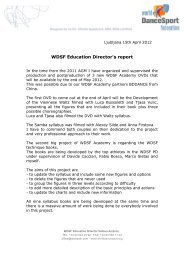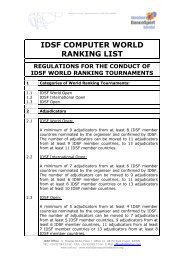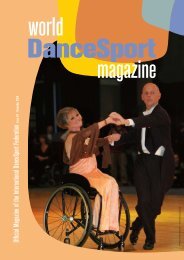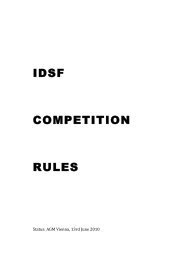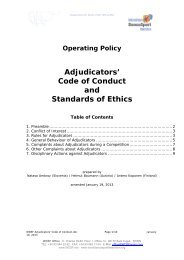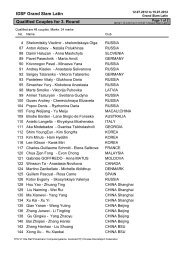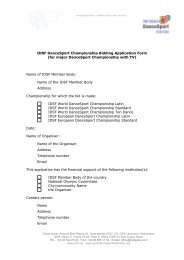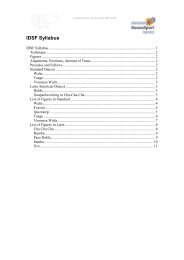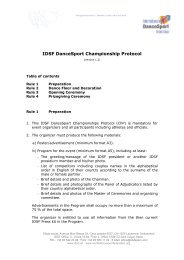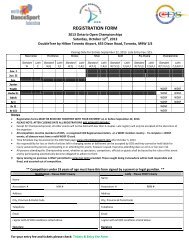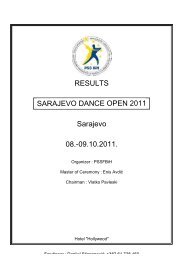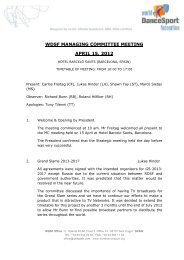Athlete Guide - Edition 5 - World Anti-Doping Agency
Athlete Guide - Edition 5 - World Anti-Doping Agency
Athlete Guide - Edition 5 - World Anti-Doping Agency
You also want an ePaper? Increase the reach of your titles
YUMPU automatically turns print PDFs into web optimized ePapers that Google loves.
CONTENTS /01. Introduction / 0202. Who’s Who in <strong>Anti</strong>-<strong>Doping</strong> / 0503. What is <strong>Doping</strong> / 1004. The List / 1305. <strong>Doping</strong> Control / 1606. Results Management / 2507. More Information / 3008. Definitions / 32
01INTRODUCTION
01/ IntroductionWhat is WADA?The <strong>World</strong> <strong>Anti</strong>-<strong>Doping</strong> <strong>Agency</strong> (WADA) is the international independentorganization created in 1999 to promote, coordinateand monitor the fight against doping in sport in all its forms.WADA, which is composed and funded equally by the sportsmovement and governments of the world, coordinated the development,and subsequent evolution, of the <strong>World</strong> <strong>Anti</strong>-<strong>Doping</strong>Code (Code).What is the <strong>World</strong> <strong>Anti</strong>-<strong>Doping</strong> Code?The Code is the document that harmonizes regulations regardinganti-doping across all sports and all countries of the world.It provides the framework for anti-doping programs and activitiesfor sport organizations and public authorities so that allathletes have the benefit of the same anti-doping policies andprocedures, no matter the sport, the nationality or the countrywhere tested.How was the Code developed?The Code was developed through an extensive consultationprocess among all stakeholders, including athletes, sports organizations,anti-doping organizations, laboratories, governments03
and many others. The Code was unanimously adopted by theSecond <strong>World</strong> Conference on <strong>Doping</strong> in Sport in 2003, came intoeffect on January 1, 2004, and was fully implemented by OlympicSport Federations in time for the 2004 Summer Olympic Games inAthens. Revisions to the Code, following an 18-month consultationwith stakeholders, were unanimously adopted by the Third<strong>World</strong> Conference on <strong>Doping</strong> in Sport in 2007, to be effectiveas of January 1, 2009.What rules or procedures has the Code put in place?The Code clarifies the responsibilities of stakeholders in thefight against doping and brings harmonization where rules orpolicies previously varied between different sports and countries.The Code operates in conjunction with five InternationalStandards: List of Prohibited Substances and Methods (List);Testing; Therapeutic Use Exemptions; Laboratories; and Protectionof Privacy and Personal Information.04
02WHO’S WHO INANTI-DOPING
The chart on page 9 and the sections below provide a broadoverview of the various players involved in the fight againstdoping under the Code.WADAIn its role of promoting, coordinating and monitoring the internationalfight against doping, WADA is engaged in manykey activities, including scientific and social science research,education, anti-doping capacity building and monitoring Codeimplementation.IOC, IPC, IFsThe International Olympic Committee (IOC) and the InternationalParalympic Committee (IPC) are responsible for the testingand results management process, including sanctioning thosewho commit anti-doping rule violations, at the Olympic andParalympic Games respectively. Activities required of InternationalFederations (IFs) by the Code include conducting testingat their respective competitions; having an out-of-competitiontesting program; implementing education programs; and sanctioningthose who commit anti-doping rule violations accordingto the Code.06
GovernmentsGovernment responsibilities in anti-doping include facilitating dopingcontrols and supporting national testing programs; withholdingfinancial support from those who engage in or support doping;taking measures against manufacturing and trafficking of illegalsubstances; and funding anti-doping education and research.NOCs, NPCs, NFsIOC and IPC rules require that National Olympic Committees(NOCs) and National Paralympic Committees (NPCs), respectively,implement the Code. IF rules must include the requirement thatNational Federations (NFs) be Code-compliant.NADOs, RADOsNational <strong>Anti</strong>-<strong>Doping</strong> Organizations (NADOs) responsibilitiesinclude testing national athletes in- and out-of-competition, aswell as athletes from other countries competing or training withinthat nation’s borders; adjudicating anti-doping rule violations;and anti-doping education. WADA is working with stakeholdersin underserved regions of the world to facilitate the creationof Regional <strong>Anti</strong>-<strong>Doping</strong> Organizations (RADOs) responsible forenhancing anti-doping capacities in that region.LabsLaboratories that are able to analyze doping control samplesunder the Code must achieve and maintain accreditation fromWADA, according to the criteria established in the InternationalStandard for Laboratories and its related technical documents.02/ Who’s Who in <strong>Anti</strong>-<strong>Doping</strong>07
CASThe Court of Arbitration for Sport (CAS) is often referred to as“sport’s supreme court.” It is an independent organization thatfacilitates the settlement of sport-related disputes, through arbitrationor mediation, by means of procedural rules adaptedto the specific needs of the sports world. WADA has a right ofappeal to CAS for doping cases under the jurisdiction of organizationsthat have implemented the Code.08
02/ Who’s Who in <strong>Anti</strong>-<strong>Doping</strong>IOC, IPC, IFsGovernmentsNOCs, NPCs, NFsNADOs, RADOs<strong>Athlete</strong>s & EntourageCASLabs09
03WHAT IS DOPING
03/ What is <strong>Doping</strong><strong>Doping</strong> is defined as the occurrence of one or more of thefollowing anti-doping rule violations:01. Presence of Prohibited Substance:Presence of a prohibited substance or its metabolites ormarkers in an athlete’s sample02. Use of Prohibited Substance/Method:.Use or attempted use by an athlete of a prohibited substanceor method03. Refusing Sample Collection:Refusing, or failing without compelling justification, to submitto sample collection after notification as authorized in applicableanti-doping rules, or otherwise evading sample collection04. Failure to File Whereabouts & Missed Tests:Violation of applicable requirements regarding athlete availabilityfor out-of-competition testing, including failure to filerequired whereabouts information and missed tests (i.e., anycombination of three missed tests and/or filing failures withinan 18-month period may be deemed a doping violation)05. Tampering:.Tampering or attempted tampering with any part of thedoping control process11
06. Possession:Possession of a prohibited substance and prohibited method07. Trafficking:Trafficking or attempted trafficking in any prohibited substanceor method08. Administration:.Administration or attempted administration to an athlete of a.prohibited substance and/or method; or assisting, encouraging,aiding, abetting, covering up or any other type of complicity.involving an anti-doping rule violation or any attemptedanti-doping rule violation12
04THE LIST
What substances and methods are banned?The List of Prohibited Substances and Methods (List), updatedannually by WADA, is the International Standard defining whatis prohibited in- and out-of-competition. The List also indicateswhether particular substances are banned in particular sports.The most current edition of the List is posted on WADA’s Website at: www.wada-ama.org.What is the “strict liability” principle?<strong>Athlete</strong>s should know that, under the Code, they are strictlyliable whenever a prohibited substance is found in their bodilyspecimen. This means that a violation occurs whether or notthe athlete intentionally, knowingly or unknowingly, used aprohibited substance or was negligent or otherwise at fault. Itis therefore very important for athletes to understand not onlywhat is prohibited, but also what might potentially cause aninadvertent doping violation.What else should athletes know about banned substancesand methods?<strong>Athlete</strong>s should always check with their IF to find out whatadditional substances and methods are prohibited in their sport.14
Also, athletes should always make their doctor aware that theyare bound by the specific rules of their sport. Those who areunsure of what a product contains should not take it until theyare sure it is not prohibited. Ignorance is never an excuse.04/ The ListWhat should I know about using supplements?Extreme caution is recommended regarding supplement use. Itis WADA’s position that a good diet is of utmost importance toathletes. The use of dietary supplements by athletes is a concernbecause, in many countries, the manufacturing and labelling ofproducts may not follow strict rules, which may lead to a supplementcontaining an undeclared substance that is prohibitedunder anti-doping regulations. A significant number of positivetests have been attributed to the misuse of supplements, andtaking a poorly labelled dietary supplement is not an adequatedefence in a doping hearing.What about medical conditions?<strong>Athlete</strong>s, like all others, may at times experience a medicalcondition that requires them to use particular medicines.The substances that an athlete may be required to take to treata condition could fall under the List. However, by applying andobtaining a therapeutic use exemption (TUE) from the IF orNADO, an athlete may be allowed to take the necessary medicine.<strong>Athlete</strong>s who need to apply for a TUE should request moreinformation about the TUE application process from their IF (forinternational-level athletes) or NADO (for national-level athletes).15
05DOPING CONTROL
05/ <strong>Doping</strong> ControlWhat are doping controls?<strong>World</strong>wide doping controls—or athlete testing—are carried out inaccordance with the Code and the International Standard for Testing(IST). <strong>Athlete</strong>s who compete at the international and nationallevel may be tested anytime, anywhere. Specially trained andaccredited doping control personnel carry out all tests.Who conducts testing?The Code states that <strong>Anti</strong>-<strong>Doping</strong> Organizations (ADOs) must planand implement an effective number of in-competition and outof-competitiontests on the athletes in their Registered TestingPools (RTP). This includes international level athletes beingtested by IFs, and international and national level athletes beingtested by NADOs, or in some cases, national governing bodiesof sport (NGBs), National Olympic Committees (NOCs) andRegional <strong>Anti</strong>-<strong>Doping</strong> Organizations (RADOs).The ADO develops a test distribution plan and allocates thenumber of samples for each sport or discipline required foreffective deterrence and detection. The plan includes out-ofcompetitiontesting, in-competition testing, and may includeblood as well as urine collection.17
What is in-competition testing?ADOs coordinate in-competition testing so that there is only oneorganization testing at an event. Unless provided otherwise inthe rules of the relevant IF or event ruling body, in-competitionmeans the period commencing 12 hours before a competitionin which the athlete is scheduled to participate through the endof the competition and the sample collection process related tothe competition. WADA does not conduct in-competition testing.Criteria for the selection of athletes is pre-determined, basedon the regulations of the relevant IF or event ruling body. It isusually the NADO of the country in which the event takes placethat collects the samples, unless the IF or event organizer hasan alternative doping control program.Sample collection takes place in accordance with the IST.<strong>Athlete</strong>s are notified of their selection for testing. Samples areanalyzed for “in-competition substances” as outlined in theProhibited List.What is out-of-competition testing?Out-of-competition testing, or any testing done outside of anevent, ensures that athletes can be tested at any time and atany place.What is the athlete’s responsibility regardingwhereabouts information?An athlete identified in the RTP by his/her ADO is required18
to provide accurate and current whereabouts information. Thisinformation is required on a quarterly basis and includes detailssuch as an athlete’s home address, training venues and schedule,competition schedule, as well as any other regular activitiessuch as work or school. Additionally, athletes identified in theirADO’s RTP must provide a specific 60-minute period for eachday when they will be accountable for a possible missed testshould they not be present for testing during this time at thedeclared location.05/ <strong>Doping</strong> ControlAny combination of 3 missed tests and/or failures to file whereaboutsinformation within an 18-month period may be considereda doping violation and may result in a sanction of between oneand two years.<strong>Athlete</strong>s outside of their ADO’s RTP may also be requested toprovide similar whereabouts information but would not be subjectto a possible “missed test” judgment under the Code.What are the requirements for athletes in team sports?<strong>Athlete</strong>s who participate in a team sport and are in a RTP are subjectto the same individual whereabouts requirements as athleteswho participate in an individual sport. The athlete may delegatethe task of making some or all of the whereabouts filing of theteam to be carried out by a coach, a manager or another thirdparty. However, each athlete remains ultimately responsible forsubmitting accurate and complete whereabouts information.19
The 12 Steps of <strong>Doping</strong> ControlThe following is a general overview of the doping control process.Departures from these procedures will not invalidate a test resultunless it is determined that the integrity of the sample hasbeen affected. More information is available on WADA’s Web siteat www.wada-ama.org or from your ADO.01. <strong>Athlete</strong> Selection.You can be selected for doping control at any time andany place.02. Notification.A <strong>Doping</strong> Control Officer (DCO) or chaperone will notify youof selection for doping control. The DCO or chaperone willinform you of your rights and responsibilities, including the.right to have a representative present throughout the process.You will be asked to sign a form confirming that you havebeen notified for doping control. For a minor or an athletewith a disability, a third party may be notified as well.03. Reporting to the <strong>Doping</strong> Control Station.You should report to the doping control station immediately.The DCO may allow you to delay reporting to the stationfor .activities such as a press conference or the completionof a .training session; however you will be accompanied bya DCO .or chaperone from the time of notification until thecompletion of the sample collection process.20
04. Selection of a Collection Vessel.You are given a choice of individually sealed collection vesselsand you may select one. You should verify that the equipmentis intact and has not been tampered with. You shouldmaintain control of the collection vessel at all times.05/ <strong>Doping</strong> Control05. Provision of Sample.Only you and a DCO or chaperone of the same gender arepermitted in the washroom during the sample provision.Minors and athletes with a disability may also have theirrepresentative present, however this representative is notpermitted to view the sample provision. The objective is toensure that the DCO is observing the sample provision correctly.06. Volume of Urine.The DCO shall ensure, in full view of the athlete, that theminimum required volume of 90 mL has been provided. Ifyou are unable to provide 90 mL, you will be asked to provideadditional urine until the minimum volume has be attained.07. Selection of a Sample Collection Kit.You are given a choice of individually sealed sample collectionkits from which to choose one. You should verify that theequipment is intact and has not been tampered with. Openthe kit and confirm that the sample code numbers on thebottles, the lids, and the container all match.08. Splitting the Sample.You split the sample, pouring the urine yourself, unlessassistance is required and you provide consent for your representativeor the DCO to do so on your behalf. Pour at least21
30 mL of urine into the B bottle; and pour the remainingurine into the A bottle. You will be asked to leave a smallamount in the collection vessel so that the DCO can measurethe specific gravity.09. Sealing the Samples.You should seal the A and B bottles. Your representative andthe DCO should verify that the bottles are sealed properly.10. Measuring Specific Gravity.The DCO is required to measure the specific gravity of thesample provided. If your sample does not meet the specificgravity requirements, you will be asked to provide an additionalsample(s).11. Completion of the <strong>Doping</strong> Control Form.You should provide information on the doping control formabout any prescription or non-prescription medication orsupplements you have taken recently. You also have theright to note comments on the form regarding the conductof the doping control session. Be sure to confirm that all ofthe information is correct, including the sample code number.You will receive a copy of the doping control form. Ensurethat the laboratory copy of the form does not contain anyinformation that could identify you.12. The Laboratory Process.Your samples are packaged for shipping to ensure that theirsecurity is tracked. They are sent to a WADA accreditedlaboratory, which will adhere to the International Standard22
for Laboratories when processing your samples, ensuringthe chain of custody is maintained at all times.Your A sample is analyzed. Your B sample is securely storedand may be used to confirm an Adverse Analytical Finding(AAF) from the A sample. The laboratory will report the resultsof your sample analysis to the responsible ADO and WADA.05/ <strong>Doping</strong> ControlWhat about blood sample collection?The same conditions that apply for urine sample collection alsoapply to blood sample collection with regard to notification,identification, escorting, and explanation of the procedure.What modifications exist for minors and athleteswith a disability?If you are a minor or an athlete with a specific type ofdisability, you may require slight modifications to the samplecollection procedure.Minors may be accompanied by an athlete representative at alltimes during the sample collection procedure, including in thewashroom area; however, the representative will not witness thepassing of the sample. If you decide not to have a representativepresent, your ADO or DCO may ask a third party to be present.If you have restricted mobility or restricted manual dexterity,you may ask the athlete representative or the DCO to assist youwhen handling equipment, splitting the sample, or completingpaperwork.23
<strong>Athlete</strong>s with significant lack of coordination may use a largercollection vessel if available.<strong>Athlete</strong>s with visual impairment may be accompanied by anathlete representative at all times during the sample collectionprocedure, including in the washroom area; however the representativewill not witness the passing of the sample. The athleterepresentative or the DCO may read the doping control formto you, and you may ask the athlete representative to sign thedoping control form on your behalf.<strong>Athlete</strong>s with an intellectual disability may be accompanied byan athlete representative at all times during the sample collectionprocedure, including in the washroom area; however the representativewill not witness the passing of the sample.<strong>Athlete</strong>s using condom drainage or indwelling catheter drainageshould remove the existing collection bag and drain the systemso that a fresh sample can be obtained.<strong>Athlete</strong>s who self-catheterize may use their own catheter toprovide a sample (this catheter should be produced in tamperevidentwrapping), or use one provided by the DCO if available.24
06RESULTSMANAGEMENT
What happens once my sample is analyzed?The laboratory that has analyzed your A sample will reportthe results simultaneously to the ADO responsible for resultsmanagement and WADA. Note that samples analyzed by laboratoriesare identified by code numbers and not athlete names.If there is an AAF on your A sample, the organization responsiblefor results management will conduct an initial review to verifywhether you had a TUE for the substance found in your sampleand to make sure that sample collection and analysis was conductedaccording to procedures.If the initial review does not justify the AAF, you will be notifiedin writing of the results and your rights regarding the analysisof your B sample. At this point, you could be provisionallysuspended according to the rules of the ADO, and you will benotified accordingly.If you decide to request a B sample analysis or if the B sampleanalysis is requested by the ADO, you may attend or choose tosend a representative on your behalf.Should the B sample analysis confirm the A sample analysis, theADO responsible for results management will proceed with theresults management process including the right to a fair hearing.26
The hearing will determine whether an anti-doping rule violationhas occurred as well as determine what sanctions will be imposed.In the event that the B sample analysis does not confirm theA sample analysis the test result will be invalidated, no furtheraction will be taken, and the provisional suspension will be lifted.06/ Results ManagementDuring competition, a mandatory provisional suspension isimposed when an A sample returns an AAF for a prohibitedsubstance (other than a specified substance). The provisionalsuspension is imposed promptly after the initial review andnotification of the athlete.Each ADO is required to make public disclosure of an anti-dopingrule violation no later than 20 days after it has been determinedin a hearing that an anti-doping rule violation has occurred.What is involved in sanctioning?The ADO that initiated sample collection is responsible fordetermining what sanctions will apply to each individual case.As an athlete, you will be given the opportunity to establish a basisfor eliminating, or reducing the sanction, or having the sanctionpartially suspended.Sanctions for violating anti-doping regulations may range froma reprimand to a lifetime ban. The period of ineligibility mayvary depending on the type of anti-doping violation, the circumstancesof an individual case, the substance, and the possiblerepetition of an anti-doping violation. For in-competition testing,this will automatically include disqualification of results obtainedin that competition and forfeiture of any medals, points, and/or27
prizes. All results of any competitions following collection of thesample may also be disqualified.Who has the right to appeal a sanction?As an athlete, you have the right to appeal any decision regardinga positive test or a sanction imposed on you following an antidopingrule violation. In general, the organization to which youmust file the appeal is an appeal body within your ADO or theCAS. Unless CAS or an appeal tribunal rules otherwise, theinitial decision remains in effect while under appeal.If another party such as an ADO or WADA were to appeal adecision regarding your case. In such case, the procedureremains the same and you would still have the right to be heardduring the proceedings.28
2906/ Results Management
07MOREINFORMATION
07/ More InformationFor more information, contact your sports federation or yourNational or Regional <strong>Anti</strong>-<strong>Doping</strong> Organization.Additional athlete resources, including the following, are availableon WADA’s Web site at www.wada-ama.org:• The <strong>World</strong> <strong>Anti</strong>-<strong>Doping</strong> Code• The Prohibited List and other International Standards• Publications about TUE requirements,the doping control process• The <strong>Anti</strong>-<strong>Doping</strong> Quiz, an online interactive gameabout anti-doping31
08DEFINITIONS
08/ DefinitionsADAMS: The <strong>Anti</strong>-<strong>Doping</strong> Administration and ManagementSystem (ADAMS) is a Web-based database management toolfor data entry, storage, sharing, and reporting designed to assiststakeholders and WADA in their anti-doping operations in conjunctionwith data protection legislation.Adverse Analytical Finding: A report from a laboratory or otherWADA approved entity that, consistent with the InternationalStandard for Laboratories and related technical documents,identifies in a sample the presence of a prohibited substance or itsmetabolites or markers (including elevated quantities of endogenoussubstances) or evidence of the use of a prohibited method.<strong>Anti</strong>-<strong>Doping</strong> Organization: A signatory to the Code that is responsiblefor adopting rules for initiating, implementing or enforcing anypart of the doping control process. This includes, for example,the International Olympic Committee (IOC), the InternationalParalympic Committee (IPC), other major event organizationsthat conduct testing at their events, WADA, International Federations(IFs), and National <strong>Anti</strong>-<strong>Doping</strong> Organizations (NADOs).<strong>Athlete</strong> Support Personnel: Any coach, trainer, manager, agent,team staff, official, medical, paramedical personnel, parent orany other person working with, treating or assisting an athleteparticipating in or preparing for sports competition.33
Attempt: Purposely engaging in conduct that constitutes a substantialstep in a course of conduct planned to culminate in thecommission of an anti-doping rule violation. Provided, however,there shall be no anti-doping rule violation based solely on anattempt to commit a violation if the person renounces theattempt prior to it being discovered by a third party not involvedin the attempt.Atypical Finding: A report from a laboratory or other WADAapproved entity which requires further investigation as providedby the International Standard for Laboratories or relatedtechnical documents prior to the determination of an AdverseAnalytical Finding (AAF).<strong>Doping</strong> Control: All steps and processes from test distributionplanning through to ultimate disposition of any appealincluding all steps and processes in between such as provisionof whereabouts information, sample collection and handling,laboratory analysis, therapeutic use exemptions (TUEs), resultsmanagement and hearings.In-Competition: Unless provided otherwise in the rules of anInternational Federation IF or other relevant anti-dopingorganization (ADO), “in-competition” means the period commencingtwelve hours before a competition in which the athleteis scheduled to participate through the end of such competitionand the sample collection process related to such competition.International Standard: A standard adopted by WADA in supportof the Code. Compliance with an International Standard (asopposed to another alternative standard, practice or procedure)34
shall be sufficient to conclude that the procedures addressed bythe International Standard were performed properly. InternationalStandards shall include any technical documents issued pursuantto the International Standard.08/ DefinitionsNational <strong>Anti</strong>-<strong>Doping</strong> Organization (NADO): The entity(ies) designatedby each country as possessing the primary authority andresponsibility to adopt and implement anti-doping rules, directthe collection of samples, the management of test results, andthe conduct of hearings, all at the national level. This includesan entity which may be designated by multiple countries toserve as Regional <strong>Anti</strong>-<strong>Doping</strong> Organization for such countries.If this designation has not been made by the competent publicauthority(ies), the entity shall be the country’s National OlympicCommittee or its designee.No Advance Notice: A doping control which takes place withno advance warning to the athlete and where the athlete iscontinuously chaperoned from the moment of notification throughsample provision.Out-of-Competition: Any doping control which is not in-competition.Possession: The actual, physical possession, or the constructivepossession (which shall be found only if the person has exclusivecontrol over the prohibited substance or prohibited method or thepremises in which a prohibited substance or prohibited methodexists); provided, however, that if the person does not haveexclusive control over the prohibited substance or prohibitedmethod or the premises in which a prohibited substance or prohibitedmethod exists, constructive possession shall only be35
found if the person knew about the presence of the prohibitedsubstance or prohibited method and intended to exercise controlover it. Provided, however, there shall be no anti-dopingrule violation based solely on possession if, prior to receivingnotification of any kind that the person has committed an antidopingrule violation, the person has taken concrete actiondemonstrating that the person never intended to have possessionand has renounced possession by explicitly declaring it to anADO. Notwithstanding anything to the contrary in this definition,the purchase (including by any electronic or other means) of aprohibited substance or prohibited method constitutes possessionby the person who makes the purchase.Prohibited List (List): The List identifying the prohibited substancesand prohibited methods.Provisional Hearing: For purposes of Article 7.5, an expeditedabbreviated hearing occurring prior to a hearing under Article 8(Right to a Fair Hearing) that provides the athlete with noticeand an opportunity to be heard in either written or oral form.Registered Testing Pool: The pool of top-level athletes establishedseparately by each IF and NADO who are subject to bothin-competition and out-of-competition testing as part of thatIF’s or NADO’s test distribution plan. Each IF shall publish alist which identifies those athletes included in its RTP either byname or by clearly defined, specific criteria.Tampering: Altering for an improper purpose or in an improperway; bringing improper influence to bear; interfering improperly;36
obstructing, misleading or engaging in any fraudulent conductto alter results or prevent normal procedures from occurring; orproviding fraudulent information to an ADO.Target Testing: Selection of athletes for testing where specificathletes or groups of athletes are selected on a non-randombasis for testing at a specified time.Testing: The parts of the doping control process involving testdistribution planning, sample collection, sample handling, andsample transport to the laboratory.Trafficking: Selling, giving, transporting, sending, delivering ordistributing a prohibited substance or prohibited method (eitherphysically or by any electronic or other means) by an athlete,athlete support personnel or any other person subject to thejurisdiction of an ADO to any third party; provided, however,this definition shall not include the actions of “bona fide”medical personnel involving a prohibited substance used forgenuine and legal therapeutic purposes or other acceptablejustification, and shall not include actions involving prohibitedsubstances which are not prohibited in out-of-competition testingunless the circumstances as a whole demonstrate suchprohibited substances are not intended for genuine and legaltherapeutic purposes.08/ Definitions37



